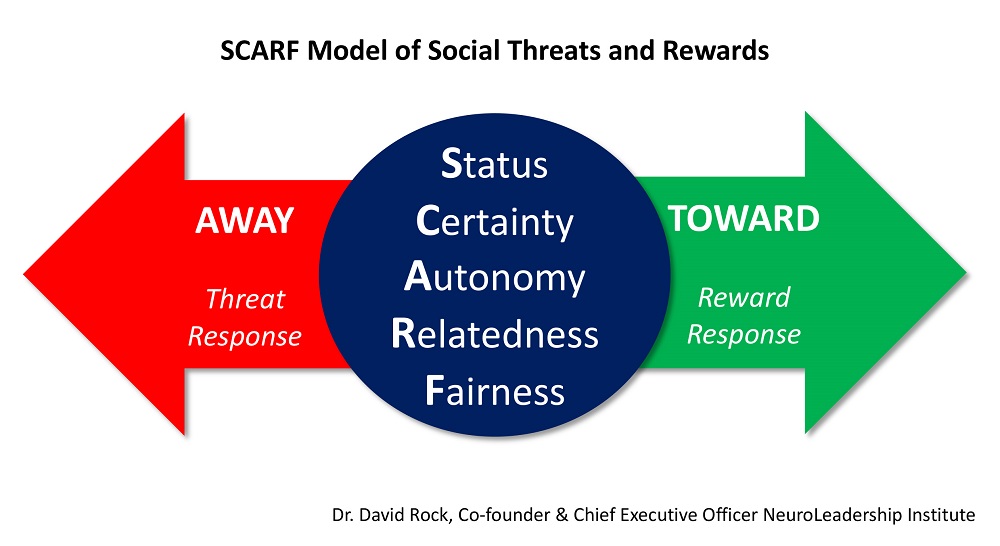You’re a business manager, leader, change agent, mentor, or coach. Your working life is all about having significant conversations that encourage collaboration, and a big part of that is influencing others. It’s a constant challenge.
As a leader everything you do and say also comes with the potential to either support or undermine an employee’s feelings of status, certainty, autonomy, relatedness and fairness at work.
When you want to create conversations that engage, influence, and drive effective collaboration, David Rock’s Scarf Model might be exactly what you need to take yourself to the next level. If you’re in a position of influence, any position of influence, this one is for you.

About the Scarf Model
You can use the Scarf Model to help you set a safer tone for a potentially difficult conversation. You can also harness it as a preparation screen method to identify the mines in the field that the conversation might evoke before they blow up in your face. So how does the SCARF model work?
Social situations or ‘social domains’ tend to come with either rewards or threats. When we feel overwhelmed by threats we respond by shutting down the body’s executive functions, which makes it hard to think straight. It happens in a variety of circumstances, when the five domains of human social experience are challenged:
- Status
- Certainty
- Autonomy
- Relatedness
- Fairness
Our social status reveals where we feel we are in the packing order. Certainty marks our perception of how well we can predict the future. Autonomy means having choices and being able to make them. Relatedness involves feeling safe with people and trusting them. Fairness revolves around fair connections and exchanges. When any of these don’t feel right, we react in an unconscious way that isn’t always helpful.
The SCARF model drives our behaviour unconsciously. If a situation arises where we might look bad, we are driven to avoid it. We avoid uncertainty, we try to steer clear of having no choice, we veer away when we feel we don’t trust people. And we’re drawn in exactly the same way towards the positive social experiences we encounter.
All this makes the SCARF model a significant framework you can use for understanding others, collaborating effectively, and influencing people to be their best selves at work.
Here’s a diagram.

The blue circle contains the things we hold dear at work, the attributes we value most in a working context. When all of them are in place we feel motivated towards the green arrow of reward and response. When they’re threatened we tend to move away in the red direction, the classic human response to threats.
Interestingly, the drive to move away from a threat response is disproportionately powerful. A threat response will send us running for the hills much faster and more efficiently than a reward response will attract us. This actually makes sense evolutionarily because the humans who noticed and acted on threats in ancient times would have survived better than those who walked towards a threat. It also explains why humans tend to focus more naturally on negatives than positives. In the distant past, being wary was a life saver.
Harness the SCARF model for yourself
Understanding this dynamic means you’ll be able to engage your employees’ talents better, support excellent levels of collaboration, and create an environment that encourages positive change. It’s all about the way you communicate with people.
Here is a short video by David Rock, explaining this model further. David is Executive Director of the NeuroLeadership Institute, and CEO of the NeuroLeadership Group, a global consulting firm. He describes how he came up with this model and the real value he sees in applying it.
You may also find his book worth reading too.

As a leader, it’s your job to be aware of your style, aware when you’re creating a threat response, and aware of ways to bolster your own natural responses so they drive people in the right direction.
If, as a leader at work, you trigger a constant stream of threat responses, employees’ brains soon become a lot less effective because people are constantly on edge, focused not on work but on escaping the threat.
When you make people feel good about themselves, communicate their expectations clearly, give them the power to make decisions, help build great relationships, and treat everyone fairly, everyone is driven towards a reward response. What does this mean in practical terms? The entire business is more effective, open and creative. People can focus better. They’re less likely to burn out. They feel intrinsically rewarded. And that’s the point where the magic happens.
About us:
We create the space for leaders to step back, think clearly, and navigate complexity with confidence. By sharpening the narrative that drives decisions, teams, and performance, we help leaders move forward with clarity and impact. Our approach blends deep listening, incisive challenge, and commercial focus—strengthening leadership at every level, from business transformation to boardroom decisions.
“We share resources that help coaches deepen their practice and expand their impact. The articles on this site are designed to spark fresh thinking, offer practical tools, and support the continuous growth of coaches at every stage. “
Jude Elliman
Founder
Our Core Approach:
We work with leaders to sharpen their thinking, strengthen their leadership, and navigate complexity with confidence. Our approach is built around three core areas:
Narrative Coaching – Working with the stories that shape leadership, teams, and organisations.
Commercial Focus – Cutting through complexity to drive clear, strategic decisions.
Challenge & Space – Asking the right questions while creating the space to reflect and grow.
Through this, we help leaders drive transformation, align teams, and make high-stakes decisions with clarity and impact.
